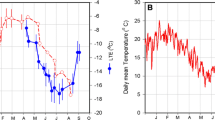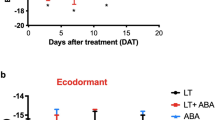Abstract
A dynamic thermal time model (DTTM) has been developed to predict cold-hardiness in dormant grapevine buds, which uses daily mean temperatures as the only input variable. However, it has been recently reported that cold-hardiness in grapevine buds depends not only on low temperatures (LTs), but also on the content of the plant phytohormone abscisic acid (ABA). An important parameter in the DTTM is the ecodormancy boundary (EDB), which represents the chilling degree days (DDc) required for the transition of the buds from endo to ecodormancy. In this study, the bud cold-hardiness of grapevines was measured by the low-temperature exotherm (LTE) in the subtropical Elqui and in the temperate Maipo valleys of Chile, and the values fitted to the DTTM. Moreover, the ABA content was determined in dormant buds throughout the dormant season. The results demonstrated that the DTTM worked better in the Maipo than in the Elqui valley, and that the content of ABA in the buds was higher in the vines grown in the Elqui valley. On the other hand, the optimized EDB parameter value varied from year to year when it was estimated as chilling accumulated, but when it was estimated as time, it remained constant in the Maipo valley. Based on the results, we conclude the following: (a) the proper functioning of the DTTM requires that the ABA content profile in the dormant buds should be kept constant from year to year, (b) the highest content of ABA in the buds collected in the Elqui valley is probably due to abiotic stresses, (c) the EDB parameter corresponds to the accumulated cold until before the buds begin their deacclimation process and not until they release from endodormancy, (d) the release of the buds from endodormancy does not depend on the accumulated cold, but on the elapsed time.



Similar content being viewed by others
References
Cragin J, Serpe M, Keller M, Shellie K (2017) Dormancy and cold hardiness transition in winegrape cultivars chardonnay and cabernet sauvignon. Am J Enol Vitic 68:95–202
Daszkowska-Golec A (2016) The role of abscisic acid in drought stress: how ABA helps plants to cope with drought stress. In Drought stress Tolerance in Plants vol 2:123–151
De la Fuente M, Linares R, Baeza P, Miranda C, Lissarrague JR (2015) Comparison of different methods of grapevine yield prediction in the time window between fruit set and Veraison. J Int Sci Vigne Vin 49:27–35
Ferguson JC, Tarara JM, Mills LJ, Grove GG, Keller M (2011) Dynamic thermal-time model of cold-hardiness for dormant grapevine buds. Ann Bot 107:389–396
Ferguson JC, Moyer MM, Mills LJ, Hoogenboom G, Keller M (2014) Modeling dormant bud cold hardiness and bud-break in twenty-three Vitis genotype reveals variation by region of origin. Am J Enol Vitic 65:59–71
Kovaleski AP, Londo JP (2019) Tempo of gene regulation in wild and cultivated Vitis species shows coordination between cold deacclimation and budbreak. Plant Sci 287:110178
Lang GA (1987) Dormancy: a new universal terminology. Hort Sci 22:817–820
Lavee S, May R (1997) Dormancy of grapevine buds-facts and speculation. Aust J Grape Wine Res 3:31–46
Pagter M, Arora R (2013) Winter survival and deacclimation of perennials under warming climates: physiological perspectives. Physiol Plant 147:75–87
Pérez FJ, Rubio S (2015) Prolonged exposure of grapevine buds to low temperatures increase dormancy, cold hardiness and the expression of Vvα-AMYs genes. In: Anderson J (ed) Advances in plant dormancy. Springer, pp 169–184
Pérez FJ, Ormeño J, Reynar B, Rubio S (2008) Use of the dynamic model for the assessment of winter chilling in a temperate and a subtropical climatic zone of Chile. Chilean Journal of Agriculture Research 68:198–206
Rubio S, Pérez FJ (2019) ABA and its signaling pathway are involved in the cold acclimation and deacclimation of grapevine buds. Sci Hortic 256:108565
Rubio S, Dantas D, Bressan-Smith R, Pérez FJ (2016) Relationship between endodormancy and cold hardiness in grapevine buds. J Plant Growth Regul 35:266–275
Rubio S, Noriega X, Pérez FJ (2019) Abscisic acid (ABA) and low temperatures synergistically increase the expression of CBF/DREB1 transcription factors and cold hardiness in grapevine dormant buds. Ann Bot 123:681–689
Veemer E, Knegt E, Bruinsma J (1987) Determination of abscisic acid in small amounts of plant material. J Chromatogr 404:346–351
Vergara R, Pérez FJ (2010) Similarities between natural and chemically induced bud-endodormancy release in grapevine Vitis vinifera L. Sci Hortic 125:648–653
Vergara R, Noriega X, Aravena KS, Prieto H, Pérez FJ (2017) ABA represses the expression of cell cycle genes and may modulate the development of endodormancy in grapevine buds. Frontiers in Plant Sci 8:812
Weiser CJ (1970) Cold resistance and injury in woody plants. Science 169:1269–1278
Wisniewski M, Gusta L, Neuner G (2014) Adaptive mechanisms of freeze avoidance in plants: a brief update. Environ Exp Bot 99:133–140
Zheng CH, Halaly T, Acheampong AK, Takebayashi Y, Jikumaru Y, Kamiya Y, Or E (2015) Abscisic acid (ABA) regulates grape bud dormancy, and dormancy release stimuli may act through modification of ABA metabolism. J Exp Bot 66:1527–1542
Acknowledgments
The computer assistance of Dr. Ricardo Pérez is gratefully acknowledged.
Funding
This work received financial support project FONDECYT 1190057.
Author information
Authors and Affiliations
Corresponding author
Additional information
Publisher’s Note
Springer Nature remains neutral with regard to jurisdictional claims in published maps and institutional affiliations.
Rights and permissions
About this article
Cite this article
Rubio, S., Pérez, F.J. Testing the Ferguson model for the cold-hardiness of dormant grapevine buds in a temperate and subtropical valley of Chile. Int J Biometeorol 64, 1401–1408 (2020). https://doi.org/10.1007/s00484-020-01920-1
Received:
Revised:
Accepted:
Published:
Issue Date:
DOI: https://doi.org/10.1007/s00484-020-01920-1




